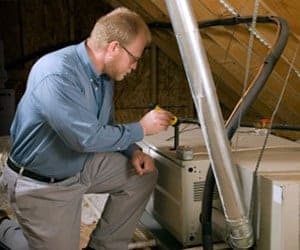Building technologies improve every year. Today's home heating products are more efficient than 10 years ago. Building codes for new construction require these the use of newer, energy efficient products by setting standards for energy efficiency from your windows, to your heating system and more. Very few of your home's systems last forever so when you need to replace a roof, a furnace or hot water heater, it makes sense to find one that is more energy efficient. Government incentives, i.e. tax credits, are often often available for home improvements that make homes safer or more energy efficient. It pays to do your homework!
Federal Tax Credits to Burn Efficiently
There are Federal Tax Credits available through year end 2010 for your “principal residence“. The credit has a cap of $1,500 for all products installed from January 1, 2009 through December 31, 2010. You need a Manufacturer’s Certification Statement, a signed statement certifying the product qualifies for the tax credit. You should be able to find this documentation on the web or by calling the manufacturer. All receipts and supporting documentation should be saved for your records although they do not need to be submitted with IRS form 5695, Residential Energy Credits.
Products eligible for the tax credit, that burn fuel to heat or cool your home are listed in the table below. Installation costs for most of these products are eligible for the tax credit. These products should installed by professionals for proper installation as mistakes can affect safety and/or energy efficiency.
Note: You may also want to read our article on Home Products that Reduce Heat Loss
| Home Products That Burn More Efficiently | % Tax Credit | Install Costs | Expiration Date |
| Biomass stoves but not the hearth, stovepipe or chimney for a biomass stove | 30% | Yes | 12/2010 |
| Fireplace inserts – Hearth, Patio, and Barbeque Association (HPBA) feel manufacturers will qualifyproducts as the EPA normally usually treats inserts and biomass stoves the same | 30% | Yes | 12/2010 |
| Advanced Main Air Circulating Fan, the fan or blower motor that blows heated air through the duct system. It may qualify even when your furnace doesn't qualify. | 30% | Yes | 12/2010 |
| Heat pumps (viable in moderate climates) | 30% | Yes | 12/2010 |
| Central air conditioning; window air conditioners and evaporative coolers are not eligible | 30% | Yes | 12/2010 |
| Natural gas, propane or oil hot water boilers that circulate water throughout the house via baseboard units, radiators or in-floor radiant tubing | 30% | Yes | 12/2010 |
| Natural gas, propane or oil furnaces that use the combustion of fuel and air to create heat | 30% | Yes | 12/2010 |
| Hot water heaters including solar powered | 30% | Yes | 12/2010 |
Biomass Stoves – You probably are familiar with wood and pellet stoves. As a group, these are called biomass stoves as they burn “biomass” fuels including wood, wood waste and residues like wood pellets, agricultural crops and trees, plants including aquatic plants, grasses and fibers.
Heating, Ventilation, Air Conditioning (HVAC) – Like a refrigerator, heat pumps move heat from a cool space to a warm space, providing up to 4 times the energy they consume. More traditional boilers and furnaces burn fuel and newer products burn more efficiently to reduce lost energy, i.e. that goes up the vent pipe.
Hot Water Heaters – Hot water consumes 14%–25% of the energy used in a home, so an efficient hot water heater can lower your utility bills significantly. Indirect hot water heaters use a heat exchanger to leverage your heating system's boiler/furnace, so they're not eligible for the tax credits.





Leave a Reply